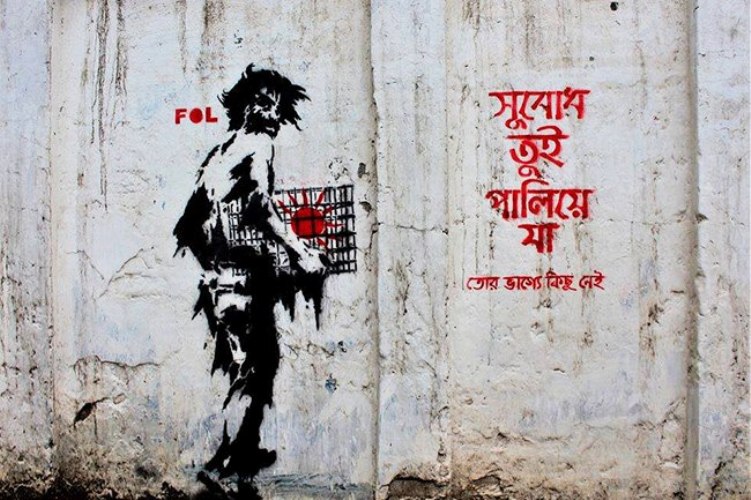
Graffiti is drawing on property with writing, symbols, or graphics. COURTESY
Graffiti (both singular and plural; the singular graffito is rarely used except in archeology) is writing or drawings made on a wall or other surface, usually without permission and within public view. Graffiti ranges from simple written words to elaborate wall paintings, and has existed since ancient times, with examples dating back to ancient Egypt, ancient Greece, and the Roman Empire.
Graffiti is a controversial subject. In most countries, marking or painting property without permission is considered by property owners and civic authorities as defacement and vandalism, which is a punishable crime, citing the use of graffiti by street gangs to mark territory or to serve as an indicator of gang-related activities. Graffiti has become visualized as a growing urban “problem” for many cities in industrialized nations, spreading from the New York City subway system in the early 1970s to the rest of the United States and Europe and other world regions. The term graffiti originally referred to the inscriptions, figure drawings, and such, found on the walls of ancient sepulchres or ruins, as in the Catacombs of Rome or at Pompeii. Use of the word has evolved to include any graphics applied to surfaces in a manner that constitutes vandalism. The only known source of the Safaitic language, an ancient form of Arabic, is from graffiti: inscriptions scratched on to the surface of rocks and boulders in the predominantly basalt desert of southern Syria, eastern Jordan and northern Saudi Arabia. Safaitic dates from the first century BC to the fourth century AD.
Modern-style graffiti
The first known example of “modern style”[clarification needed] graffiti survives in the ancient Greek city of Ephesus (in modern-day Turkey). Local guides say it is an advertisement for prostitution. Located near a mosaic and stone walkway, the graffiti shows a handprint that vaguely resembles a heart, along with a footprint, a number, and a carved image of a woman's head. The ancient Romans carved graffiti on walls and monuments, examples of which also survive in Egypt. Graffiti in the classical world had different connotations than they carry in today's society concerning content. Ancient graffiti displayed phrases of love declarations, political rhetoric, and simple words of thought, compared to today's popular messages of social and political ideals. The eruption of Vesuvius preserved graffiti in Pompeii, which includes Latin curses, magic spells, declarations of love, insults, alphabets, political slogans, and famous literary quotes, providing insight into ancient Roman street life. One inscription gives the address of a woman named Novellia Primigenia of Nuceria, a prostitute, apparently of great beauty, whose services were much in demand. Another shows a phallus accompanied by the text, mansueta tene (“handle with care”).
Graffiti is drawing on property with writing, symbols, or graphics. Although considered as a form of art by many, it bears a negative connotation because usually it is done on surfaces without the consent of the property’s owner. Whether graffiti is an art or crime has long been argued. Different types of graffiti have different purposes and the artwork may also become criminally culpable, depending on its nature. The fact that it is drawn without any consent, makes it a trespass on property and one of the most visible signs of antisocial behavior in society. Graffiti can incite violence and provoke racism as seen in the past in so many countries. The detrimental impact is not only on the property owner; it is often linked to other crimes as well. A Swedish research found escalating deviant behaviour amongst taggers (who draw graffiti). In Australia, the annual cost for cleaning the drawings is around 200 million Australian dollars. Thus, around the globe it has evolved from being mere anonymous artwork to pressing criminal activity.
Why indulge in graffiti?
Research has found that young adolescents are more involved in such drawings. To relieve boredom and stress, and gain recognition for their artistic talent, young people get inclined to tagging. Dr Lynne Vieraitis and Arthur Vasquez interviewed 25 Dallas taggers to explore why they paint graffiti and how they rationalise the crime. The taggers claimed that no physical harm is caused, and reasoned that instead of tagging, they could have been involved in gang activity or other crimes. Some answered that the drawings can be cleaned easily and by defacing property, they were actually providing work for the cleaners. Expression of thought is our freedom and protesting against the wrong is a right, but the voice has to be raised in a proper way and through an appropriate medium This kind of self-justifications can be related to Drift theory by prominent criminologist David Matza. He theorised that the delinquents do not see their work as a crime because they don’t realise the crime they commit by damaging someone’s property.






0 Comments